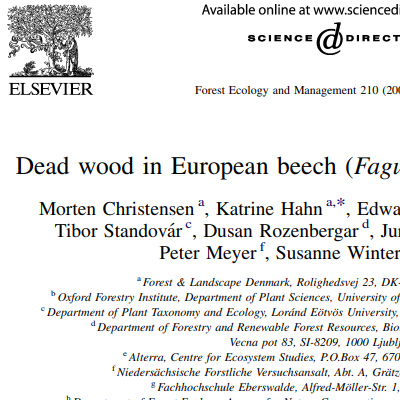Data were analysed on the volume of dead wood in 86 beech forest reserves, covering most of the range of European beech forests. The mean volume was 130 m3/ha and the variation among reserves was high, ranging from almost nil to 550 m3/ha. The volume depended significantly on forest type, age since reserve establishment and volume of living wood. More dead wood was found in montane (rather than lowland/submontane) reserves, longer-established reserves (time since designation) and reserves
with higher volumes of living wood.
On average, fallen dead wood contributed more to the total dead wood volume than standing dead wood. The percentage of dead wood that was standing was almost twice as high in montane than in lowland/submontane forest reserves (45% versus 25%). The volume of dead wood at selected sites changed considerably over time. The fluctuations were significantly higher in lowland/submontane than montane reserves, possibly connected with differences in the disturbance regimes and especially damage caused by windstorms. In NW Europe, the blow down of formerly managed, even-aged stands led to extraordinary high volumes of dead wood shortly after reserve establishment.
The implications for forest management and biodiversity conservation are discussed. An increase in dead wood
volumes must be carried out in accordance with the local/regional forest type and disturbance regime. Thus, in order to fulfil the requirements of as many wood-depending organisms as possible, it is important to preserve not only larger amounts of dead wood, but also dead wood of different types and dimensions as well as securing a long-term continuity of dead wood.
Contribution of Hungary were obtained from Kékes, Őserdő (Bükk) and Alsóhegy strict forest reserves.
1. Introduction
2. Materials and methods
3. Results
3.1. Description of forest reserves
3.2. Dead wood volumes
3.3. Standing and fallen dead wood
3.4. Dead wood dynamics
4. Discussion
4.1. Total dead wood volumes
4.2. Dead to live wood ratio
4.3. Standing and fallen dead wood
4.4. Dead wood dynamics and disturbance regimes
4.5. The reference value for forest management and biodiversity conservation
Acknowledgements
References
biodiversity, coarse woody debris, CWD, Fagus sylvatica, indicator, nature-based forest management, sustainability
Címszavazva - GE
